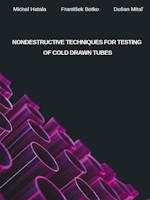|
 |
Introduction
At present, non-destructive testing is an integral part of virtually all industries. Being able to „see “inside any component without compromising its integrity is a huge advantage and an economic benefit at the same time. Methods of non-destructive material testing use various physical principles that enable finding even the smallest defects, whether on the surface, near the surface but also at greater distances from the surface of the inspected component. The present monograph is focused on an overview of physical principles, approaches and technical equipment of two very well combinable methods of non-destructive testing. The technique of ultrasonic non-destructive testing is one of the volumetric methods for testing materials, and its application makes it possible to check and detect internal defects at any distance from the surface of the tested component. It uses the propagation of mechanical vibrations in solids at high frequencies and their reflection from the acoustic interface. Thanks to the known speed of sound propagation in specific solids, it is possible to determine the position and size of a defect very accurately. The eddy current method belongs to a surface methods category, i.e. its radius of action are the surface and subsurface layers of the tested components. It is based on the principle of eddy currents in the tested object, which are excited by the alternating magnetic field of the probe (coil). Eddy currents tend to close in a loop. If the excited eddy currents reach a defect inside the material or an environment with a different conductivity and permeability, their flow changes. This results in a change in the secondary magnetic field excited by the eddy currents, and thus a change in the volt-ampere characteristic detected by the probe. By combining ultrasonic testing and the eddy current method, it is possible to cover both the surface and near-surface layers, as well as the volume of material below the surface of the component. These methods are widely used in the inspection of cold drawn pipes, for they are able to detect surface cracks, as well as internal defects, across the entire volume of the final product. The great advantage of both methods is the possibility of in situ defect detection in course of the respective technological process. This makes it possible to address the problem immediately and eliminate the same at minimum downtime.
